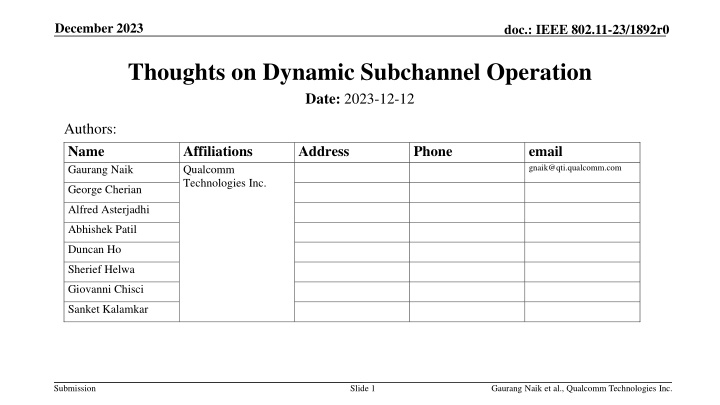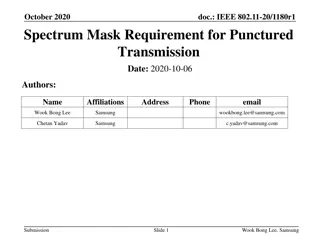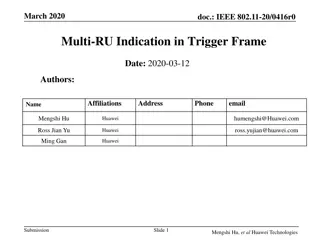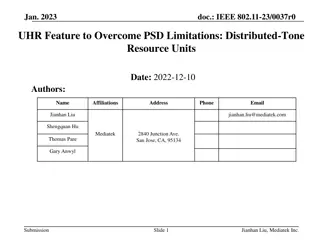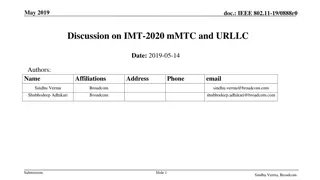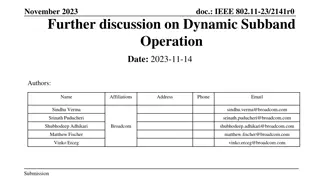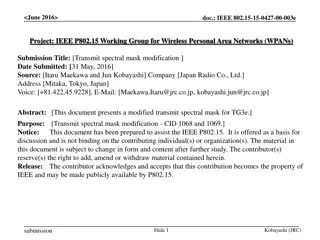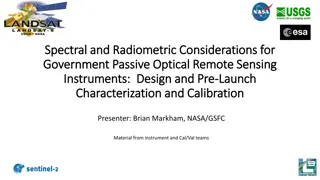Dynamic Subchannel Operation in IEEE 802.11-23/1892r0: Enhancing Spectral Efficiency
The document discusses the implementation of Dynamic Subchannel Operation in IEEE 802.11 to address underutilization of bandwidth by narrowband devices. By allowing dynamic switching to secondary subchannels, the aim is to maximize spectral efficiency and enable communication with narrowband STAs on nonprimary subchannels. Theoretical gains analysis and design considerations are also outlined to support this enhancement.
Download Presentation

Please find below an Image/Link to download the presentation.
The content on the website is provided AS IS for your information and personal use only. It may not be sold, licensed, or shared on other websites without obtaining consent from the author.If you encounter any issues during the download, it is possible that the publisher has removed the file from their server.
You are allowed to download the files provided on this website for personal or commercial use, subject to the condition that they are used lawfully. All files are the property of their respective owners.
The content on the website is provided AS IS for your information and personal use only. It may not be sold, licensed, or shared on other websites without obtaining consent from the author.
E N D
Presentation Transcript
December 2023 doc.: IEEE 802.11-23/1892r0 Thoughts on Dynamic Subchannel Operation Date: 2023-12-12 Authors: Name Gaurang Naik Affiliations Qualcomm Technologies Inc. Address Phone email gnaik@qti.qualcomm.com George Cherian Alfred Asterjadhi Abhishek Patil Duncan Ho Sherief Helwa Giovanni Chisci Sanket Kalamkar Submission Slide 1 Gaurang Naik et al., Qualcomm Technologies Inc.
December 2023 doc.: IEEE 802.11-23/1892r0 Introduction Many Wi-Fi clients do not support the full bandwidth option supported by the AP While APs may support up to 320 MHz, client may support only 80 MHz, or 160 MHz When the AP has traffic for multiple STAs, if at least one client is wideband, Multi-User OFDMA can be used to schedule Resource Units (RUs) to the wideband STA in S80 or S160 If no such client exists, large portions of the operational bandwidth go underutilized, leading to poor spectral efficiency 802.11bn must address such underutilization by allowing narrowband devices to use different portions of the operational bandwidth Frequency S80 WIFI 7 Unutilized resource In-BSS Transmission to 160 MHz STA S40 In-BSS Transmission to 40 MHz STA S20 P20 subchannels Time Submission Slide 2 Gaurang Naik et al., Qualcomm Technologies Inc.
December 2023 doc.: IEEE 802.11-23/1892r0 Background & Objective Communicating with narrowband STAs on a nonprimary subchannel is possible in 802.11 Using the Subchannel Selective Transmission (SST) feature defined in 802.11ah and 802.11ax However, SST uses individual TWT to negotiate semi-static Service Periods during which narrowband STAs switch to nonprimary subchannels. Objective of Dynamic Subchannel Operation: Maximize spectral efficiency by allowing dynamic switching to secondary subchannels Frequency S80 In-BSS Transmission to 80 MHz STA3 WIFI 8 In-BSS Transmission to 160 MHz STA In-BSS Transmission to 40 MHz STA2 S40 In-BSS Transmission to 40 MHz STA1 S20 P20 Time subchannels Submission Slide 3 Gaurang Naik et al., Qualcomm Technologies Inc.
December 2023 doc.: IEEE 802.11-23/1892r0 Theoretical Gains Analysis Scenario Single BSS M + N associated STAs, where M = # of STAs that support entire BW N = # of narrowband STAs BW configuration Total BW = W BW of narrowband STAs = W1 BandwidthRatio = W/W1 Frequency Narrowband TX enabled by DSO Narrowband TX enabled by DSO W Wideband TX Wideband TX Narrowband TX Narrowband TX W1 Time Submission Slide 4 Gaurang Naik et al., Qualcomm Technologies Inc.
December 2023 doc.: IEEE 802.11-23/1892r0 Design Considerations Capabilities and requirements for enabling Dynamic Subchannel Operation The narrowband STAs must be capable of switching their radios dynamically from primary subchannel to a secondary subchannel and vice versa. These switches may incur delays. The narrowband STA must be capable of receiving frames on secondary subchannels that are sent in a single PPDU that spans the primary and secondary subchannels Set of secondary subchannels is determined based on the STA s BW and anchor channels announced by the AP The narrowband STA must be able to select the anchor channels it is willing to switch to for DSO Switching back & forth The non-AP STA keeps its radio parked on the primary (e.g., P20) channel The non-AP STA switches to the secondary subchannel when the AP instructs it to do so The AP performs an initial frame exchange to signal the secondary subchannel Uplink transmissions on the secondary subchannels are Trigger-based only The non-AP STA switches back to the primary subchannel when it detects no frame addressed to it within a timeout interval that starts at the trailing edge of the last PPDU sent/received by the STA Similar to EMLSR frame exchange sequence rules Submission Slide 5 Gaurang Naik et al., Qualcomm Technologies Inc.
December 2023 doc.: IEEE 802.11-23/1892r0 Basic Frame Exchange Sequence AP announces two anchor channels (A-1 and A-2) STA1 (80 MHz) may be legacy and need not support DSO; STA2 (80 MHz) supports DSO and picks A-2 as the anchor channel In the initial frame exchange, the AP assigns RUs to STA2 only in the 80 MHz subchannel associated with A-2 STA2 may only monitor A-2 (e.g., for preambles of incoming PPDUs) After STA2 sends the ACK, it waits on S80 for an additional timeout interval of aSIFSTime + aSlotTime + aRxPhyStartDelay Frequency When no frame is addressed to STA2 during the timeout interval, it initiates switch back to P20 BSR Ack In-BSS Transmission to 80 MHz STA2 BSRP Trigger frame BSS bandwidth STA1 (UL) (DL) (UL) A-2 non-HT dup PPDU At the end of the DSO transition delay, STA2 has parked its radio back on P20 BSR In-BSS Transmission to 80 MHz STA1 Ack A-1 STA2 (DL) (DL) (UL) (UL) P20 Time DSO Transition Delay STA1 parked on P20 Communicate with STA2 to indicate the start of DSO frame exchange AP and STAs exchange frames on the designated subchannels in an OFDMA PPDU. More than one SIFS-separated PPDUs may be exchanged Submission Slide 6 Gaurang Naik et al., Qualcomm Technologies Inc.
December 2023 doc.: IEEE 802.11-23/1892r0 Signaling Considerations The AP must indicate the following Whether it supports DSO mode Location of anchor channels The STA must indicate the following Whether it supports DSO mode Delays associated with switching Anchor channels it is willing to use Signaling is also required to enable/disable the DSO mode Submission Slide 7 Gaurang Naik et al., Qualcomm Technologies Inc.
December 2023 doc.: IEEE 802.11-23/1892r0 Conclusions In this presentation, we present our views on Dynamic Subchannel Operation with focus on: Capabilities and requirements Mechanism for switching across subchannels and frame exchange sequence Signaling considerations Submission Slide 8 Gaurang Naik et al., Qualcomm Technologies Inc.
November 2023 doc.: IEEE 802.11-23/1892r0 SP Do you agree that TGbn will define a Dynamic Subchannel Operation (DSO) mode of operation where non-AP STAs can be allocated resources dynamically (i.e., on a per-TXOP basis) outside of their current operating bandwidth within the associated AP s operating bandwidth? Submission Slide 9 Gaurang Naik et al., Qualcomm Technologies Inc.
